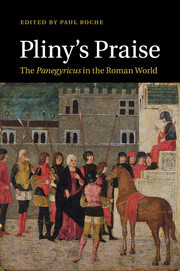Book contents
- Frontmatter
- Contents
- List of contributors
- Preface
- 1 Pliny's thanksgiving: an introduction to the Panegyricus
- 2 Self-fashioning in the Panegyricus
- 3 The Panegyricus and the Monuments of Rome
- 4 The Panegyricus and rhetorical theory
- 5 Ciceronian praise as a step towards Pliny's Panegyricus
- 6 Contemporary contexts
- 7 Politics and the sublime in the Panegyricus
- 8 Down the Pan: historical exemplarity in the Panegyricus
- 9 Afterwords of praise
- Bibliography
- Index locorum
- General index
Preface
Published online by Cambridge University Press: 05 June 2011
- Frontmatter
- Contents
- List of contributors
- Preface
- 1 Pliny's thanksgiving: an introduction to the Panegyricus
- 2 Self-fashioning in the Panegyricus
- 3 The Panegyricus and the Monuments of Rome
- 4 The Panegyricus and rhetorical theory
- 5 Ciceronian praise as a step towards Pliny's Panegyricus
- 6 Contemporary contexts
- 7 Politics and the sublime in the Panegyricus
- 8 Down the Pan: historical exemplarity in the Panegyricus
- 9 Afterwords of praise
- Bibliography
- Index locorum
- General index
Summary
This volume was conceived in the belief that Pliny's Panegyricus deserves and will reward more concentrated scholarly attention than it has traditionally received. Neglect is a natural topos in scholarly prefaces, but it has genuine substance here; in fact, neglect of the speech has not infrequently sharpened into antipathy, but neither is justified. A professed cultural disdain for formal praise threatens to alienate us from a speech whose survival makes it for us a unique specimen of early imperial senatorial oratory, whose multiple agendas so easily and obviously (indeed explicitly: Pan. 4.1) transcend the mere delivery of praise, and whose political outlook ranks it variously as a senatorial manifesto and a classic locus of imperial public-image making. But this same aversion would likewise alienate us from a vital witness to an emperor who self-consciously styled himself as a kind of epitome of imperial rule, who occupies in more ways than one a crucial liminal phase between the principates of the first and second centuries, and whose early years as emperor would otherwise be almost completely occluded to us. The Panegyricus is a key document in the evolution of imperial leadership ideals, but it is also a key text more generally for comprehending early imperial Rome.
The original idea for this volume was to have represented in one place examinations of the Panegyricus' various historical and rhetorical contexts, as well as studies offering critical engagement with the literary fabric of the Latin text as we have it.
- Type
- Chapter
- Information
- Pliny's PraiseThe Panegyricus in the Roman World, pp. ix - xPublisher: Cambridge University PressPrint publication year: 2011

